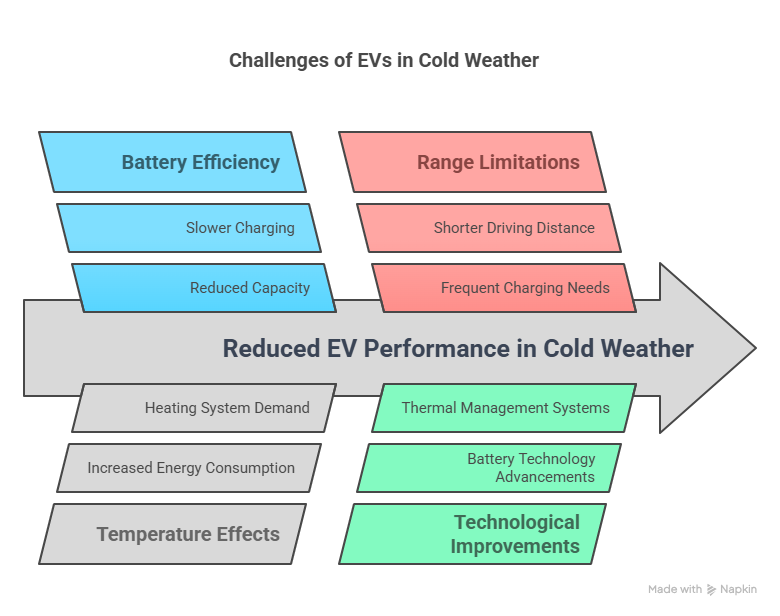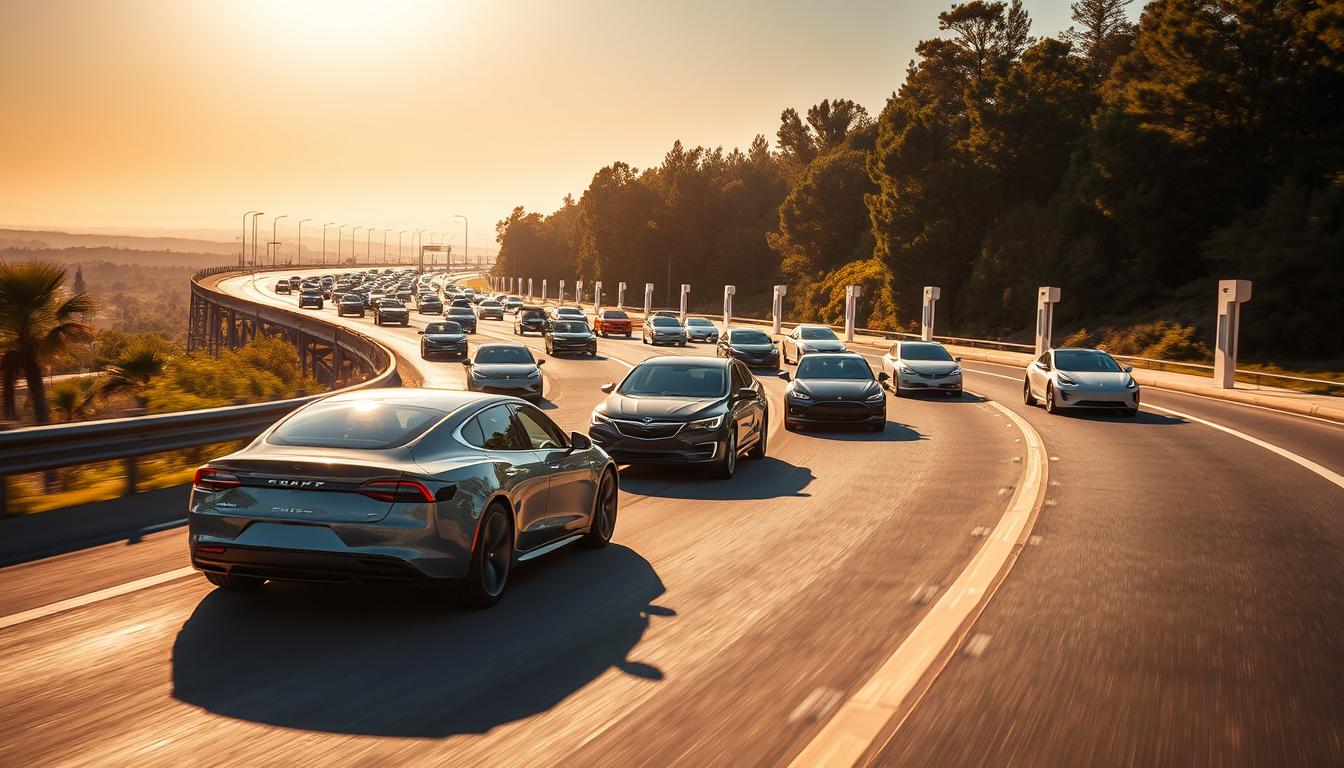s the world shifts towards more sustainable options, electric vehicles (EVs) have gained significant attention. However, a growing concern among EV owners and potential buyers is how these vehicles perform in cold weather conditions.
The harsh reality is that cold temperatures can significantly impact the performance and range of EVs. A recent examination highlighted the challenges faced by electric cars during the winter months, sparking a debate about their usability in such conditions.
This article delves into the issues affecting EVs in winter, exploring the reasons behind their reduced performance and what this means for consumers.
Key Takeaways
- EVs face significant challenges in cold weather, affecting their performance and range.
- Cold temperatures can reduce the efficiency of EV batteries.
- Understanding these challenges is crucial for both current and potential EV owners.
- The impact of winter on EVs is a critical consideration for those living in colder climates.
- Manufacturers are working on improving EV technology to mitigate these effects.

The Cold Reality: New Test Reveals Electric Cars Are Practically Unusable in Winter
The reality of driving electric vehicles in winter is far from ideal, as a new test demonstrates. The test, designed to assess the performance of electric cars in cold weather, has revealed some startling results.
Details of the Recent Winter Performance Test
The test was conducted under controlled conditions to ensure accurate and comparable results. The methodology and conditions are crucial in understanding the test’s findings.
Test Conditions and Methodology
The test was carried out in a cold climate region with temperatures ranging from -10°C to -20°C. The vehicles were driven on a mix of urban and highway routes to simulate real-world driving conditions.
Vehicles Included in the Study
A total of five electric vehicles from different manufacturers were included in the test, representing some of the most popular models in the market. The vehicles were the Tesla Model 3, Nissan Leaf, Hyundai Kona Electric, Audi e-tron, and Jaguar I-PACE.
Key Findings and Performance Metrics
The test results highlighted significant reductions in range and charging speeds for the electric vehicles tested.
Range Reduction Percentages
The average range reduction was found to be around 30% for most vehicles, with some models experiencing a reduction of up to 40% in extreme cold.
Charging Speed Limitations
Charging speeds were also affected, with a decrease of up to 25% in charging rate observed at very low temperatures.
| Vehicle Model | Range Reduction (%) | Charging Speed Reduction (%) |
|---|---|---|
| Tesla Model 3 | 32% | 20% |
| Nissan Leaf | 35% | 22% |
| Hyundai Kona Electric | 30% | 18% |
| Audi e-tron | 28% | 15% |
| Jaguar I-PACE | 38% | 25% |
Real-World Implications for EV Owners
For electric vehicle owners, these findings mean that winter driving requires more planning and potentially more frequent charging stops. Understanding these limitations is crucial for a smooth driving experience.
Understanding the Science Behind EV Winter Challenges
As the temperature drops, electric vehicles (EVs) face significant challenges that affect their performance and range. The cold weather impacts various aspects of EVs, from battery efficiency to cabin heating.
Battery Chemistry and Cold Temperature Effects
Cold temperatures significantly affect the battery chemistry of electric vehicles. Lithium-ion batteries, which are commonly used in EVs, experience a decrease in performance in sub-zero temperatures.
Lithium-Ion Battery Performance in Sub-Zero Temperatures
Lithium-ion batteries suffer from reduced capacity and increased internal resistance in cold weather, leading to decreased range and efficiency. This reduction in performance is due to the slowing down of chemical reactions within the battery.
Chemical Reactions and Resistance Increase
The cold causes the chemical reactions within the battery to slow, increasing the internal resistance. This results in less efficient energy transfer and reduced overall battery performance.
Cabin Heating Systems and Energy Consumption
Cabin heating is another critical aspect affected by cold weather. EVs use different heating systems, such as resistance heating and heat pumps, to maintain cabin temperature.
Resistance Heating vs. Heat Pumps
Resistance heating is straightforward but consumes a lot of energy, directly drawing from the battery. Heat pumps, on the other hand, are more efficient as they transfer heat rather than generate it.
Power Draw Comparison to Gas Vehicles
Unlike gas vehicles, which use waste heat from the engine for cabin heating, EVs rely on their battery, increasing energy consumption.
https://www.youtube.com/watch?v=w_pxSn-ytb4This difference significantly impacts the range of EVs in cold weather.
Regenerative Braking Limitations in Cold Weather
Regenerative braking, a key feature of EVs that captures kinetic energy and converts it back into electrical energy, is also affected by cold temperatures. The efficiency of regenerative braking decreases in cold weather, further impacting the vehicle’s range.
Practical Solutions for Electric Vehicle Winter Driving
As the temperature drops, electric vehicle owners face unique challenges that can be mitigated with the right strategies. Understanding these challenges and implementing a few simple practices can significantly improve an EV’s winter performance.
Pre-Conditioning While Plugged In
One of the most effective ways to preserve your EV’s range during winter is to pre-condition the vehicle while it’s still plugged into a charger. Pre-conditioning involves heating the cabin and battery to optimal temperatures, which can be done without draining the battery. This simple step can make a significant difference in your vehicle’s overall efficiency and comfort.
Winter Driving Techniques for Maximum Range
Adopting specific winter driving techniques can also help maximize your EV’s range. This includes driving at moderate speeds, using regenerative braking wisely, and minimizing the use of heating systems when possible. By being mindful of your driving habits, you can reduce the strain on your vehicle’s battery.
Technological Improvements on the Horizon
The future looks bright for EV owners, with technological advancements on the horizon aimed at improving winter performance. Innovations in battery technology and more efficient heating systems are being developed to mitigate the effects of cold weather on EVs. Staying informed about these developments can help current and prospective EV owners make the most of their vehicles.
Conclusion
A recent test has brought to light the significant challenges electric cars face in winter conditions, revealing that they are practically unusable in extreme cold. The findings underscore the need for electric vehicle (EV) owners to be aware of these limitations and take steps to mitigate them.
Practical solutions such as pre-conditioning while plugged in and adopting winter driving techniques can help maximize range and efficiency. Furthermore, ongoing technological advancements are expected to improve EV performance in cold weather.
As the automotive industry continues to evolve, understanding the impact of winter on electric cars is crucial. By acknowledging these challenges and leveraging available solutions, EV owners can optimize their vehicle’s performance even in harsh winter conditions.
FAQ
How do electric cars perform in extremely cold temperatures?
Electric cars can experience a significant reduction in range and performance in extremely cold temperatures due to the impact of cold weather on battery chemistry and energy consumption.
What is the impact of winter on electric vehicle range?
The range of electric vehicles can be reduced by up to 40% or more in cold weather, depending on the vehicle, driving habits, and climate conditions, as cold temperatures affect battery performance and increase energy consumption for cabin heating.
How can I maximize my electric car’s range during winter driving?
To maximize your electric car’s range during winter, pre-condition your vehicle while it’s still plugged in, drive smoothly, maintain proper tire pressure, and consider using a heat pump or other efficient heating systems.
Are there any electric vehicles that perform better in cold weather?
Some electric vehicles, such as those equipped with advanced battery management systems, heat pumps, or other technologies, may perform better in cold weather than others. Researching and comparing the cold-weather performance of different models can help you make an informed decision.
How do electric vehicle manufacturers address winter performance challenges?
Electric vehicle manufacturers are continually working to improve winter performance through advancements in battery technology, more efficient heating systems, and other innovations, such as improved thermal management systems and optimized software.
Can regenerative braking still be effective in cold weather?
Regenerative braking can be less effective in cold weather due to the reduced efficiency of the battery and other factors, but many modern electric vehicles are designed to adapt to these conditions and still capture some kinetic energy.
What are some upcoming technological improvements that can help mitigate winter-related challenges for electric vehicles?
Advancements in battery technology, more efficient heating systems, and improved thermal management are some of the technological improvements on the horizon that can help mitigate winter-related challenges for electric vehicles, making them more efficient and practical in cold weather.




